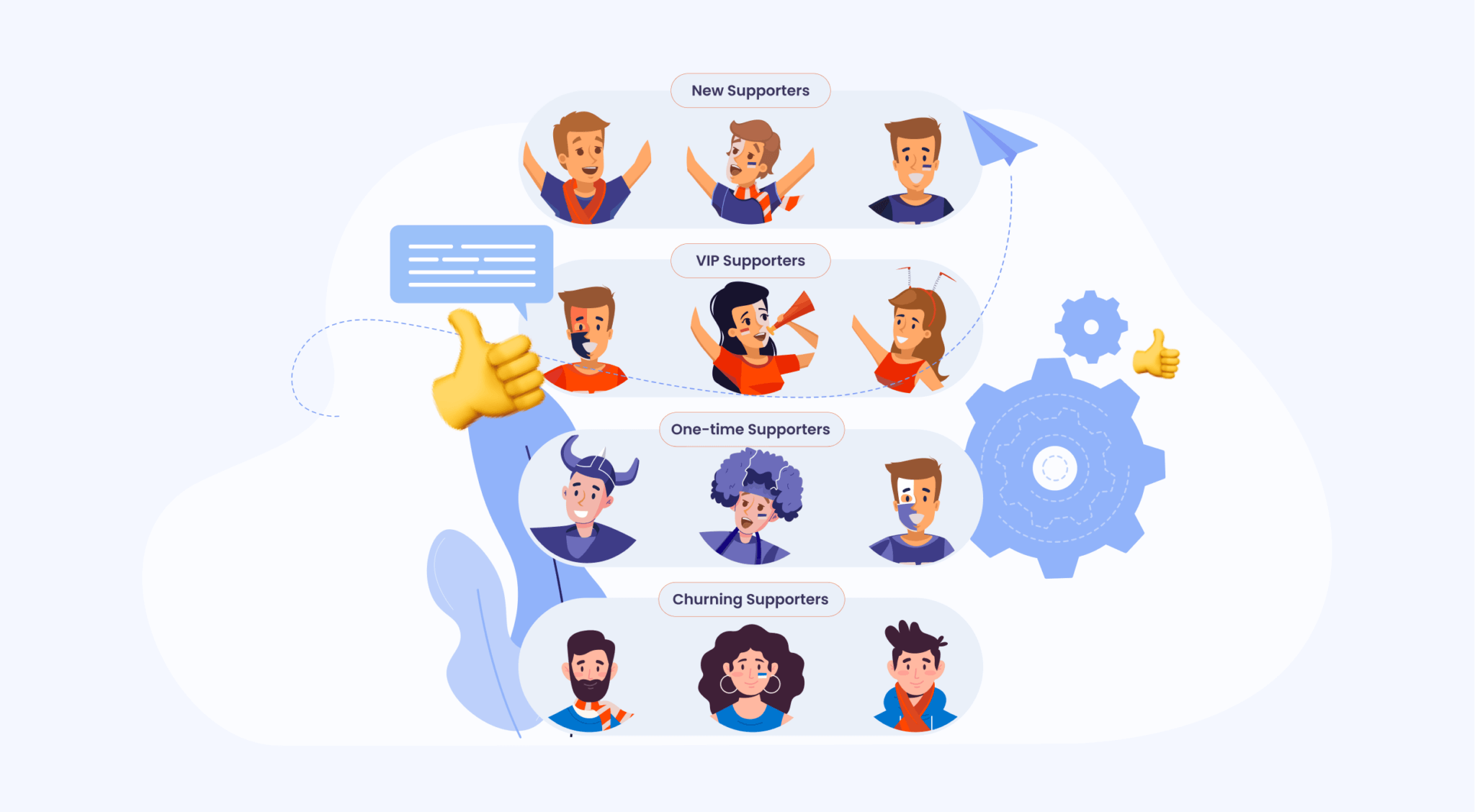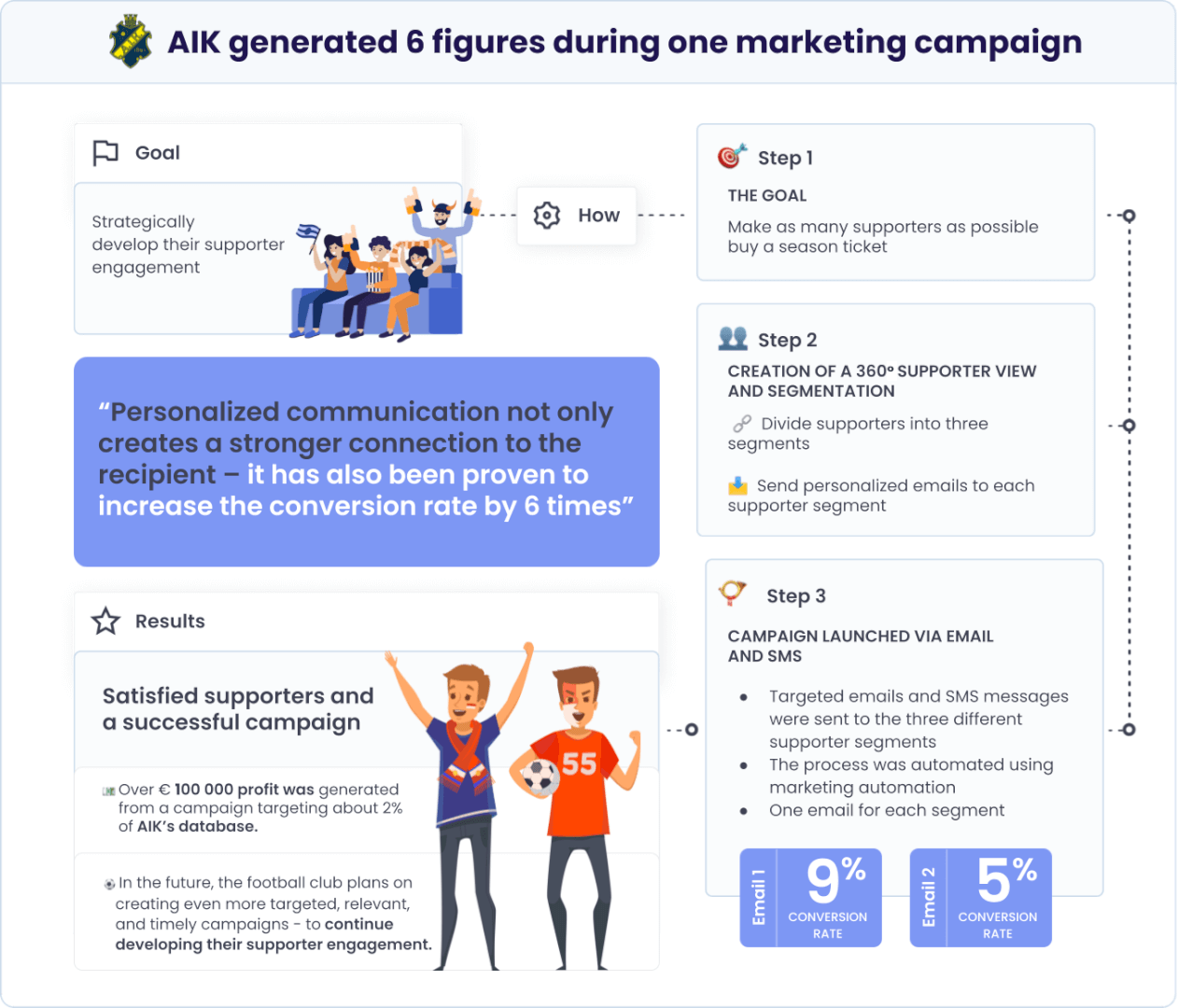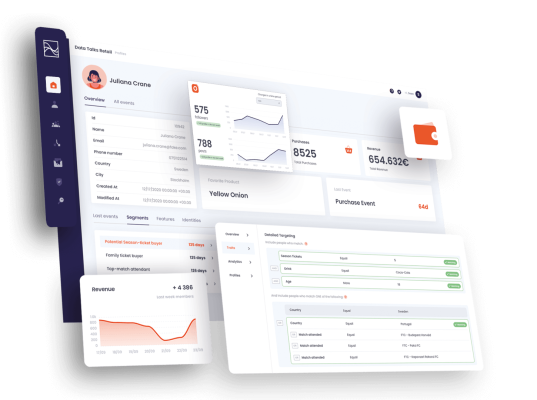
RFM analysis for sports clubs – what does it mean and why should sports clubs consider using this model?
In this blog post, we will be covering:
- What RFM analysis is
- Why RFM analysis is important for sports clubs
- 3 use cases you can use to get started
Ready? Let’s jump right in!
Before we dive right in...
Subscribe to our blog today to ensure that you never miss valuable posts such as this one. We are passionate about helping sports organizations deliver a world-class fan experience, because better fan experience means better business. So why not use this opportunity to the fullest?

What is RFM analysis?
RFM analysis is a marketing analysis tool used to segment your customers (in our case, fans) based on their purchasing habits and/or patterns. By using these insights, your sports organization can identify who your top and most loyal and engaged fans are.
So what factors do you evaluate? When using the RFM model, you analyze three main factors, namely each fan’s purchase:
- Recency: how long ago a customer/fan made their last purchase.
- Frequency: how often your customer/fan makes a purchase.
- Monetary: how much money a customer/fan spends on a purchase.
So how do you measure each of these three categories? By using a scoring scale of 1-5, with 1 being the worst and 5 being the best in each category. Thus, your most high-level fans score the highest in all three categories, while more passive fans score lower.
“Essentially, the RFM model corroborates the marketing adage that ‘80% of business comes from 20% of the customers.’”
– Investopedia, 2022
As you can see, RFM analysis is a great way to predict how likely a fan is to buy something from you again. So, the idea behind RFM is quite simple and basically assumes the following three things:
Recency:
Fans that have purchased something from you recently, such as tickets or merchandise, are more likely to buy from you again than those fans who haven’t bought anything recently.
Frequency:
Fans that buy from you more often are more likely to buy from you again compared to fans who don’t buy tickets or merchandise from you as frequently.
Monetary:
Fans that spend more are more likely to buy from you again than those who spend less.
Based on this information, you can adjust how to treat your different fans accordingly. Which brings us to an important question:

Why is RFM analysis important for sports clubs?
As we have mentioned earlier in this blog post, the main objective of the RFM model is to:
Identify who your most loyal and engaged fans are.
However, identifying each fan’s spending habits and uncovering which ones are your most engaged fans is only one part of the equation. Because what is also important, if not even more important, is how you act on the insights you receive from your RFM analysis. Because, after all, what you ultimately want to do is:
- Optimize your marketing efforts
- and the supporter experience
And this is one of the greatest strengths of the RFM for sports clubs. By segmenting your fan base into different groups based on the RFM model, you can then adapt how you approach each group based on their specific behaviors. More specifically, you can act on the insights uncovered from your fan data and target each fan segment with personalized marketing campaigns including:
- The right message
- At the right time
- In their preferred channel
This means that you would, for instance, target fans that purchase merchandise more frequently and for more money with a special deal thanking them for their loyalty. And when dealing with a more passive fan, you could for instance target them with a “reactivation” campaign to create an incentive to purchase more frequently. As you can imagine, there are many ways in which you can leverage the insights you receive from your RFM analysis.
However, a challenge many sports organizations stumble upon is how exactly they can do RFM analysis in practice. After all, collecting and analyzing all of your fan’s behavioral data can perhaps feel a bit overwhelming, especially if you have a bigger fan base. Fortunately, Sports Customer Data Platforms have been specifically designed to:
- Collect and unify data in one single place
- Create a 360-degree view of each fan, including deep insights into each fan’s unique characteristics, preferences, and behaviors.
- Segment fans into different groups in real-time (using for instance RFM analysis)
- Act on your insights and target each segment with personalized communications and marketing campaigns – which are sent automatically from the CDP in each fan’s preferred channels.
To give you an idea of how powerful targeting a specific segment with personalized campaigns can be when done right, check out the success story of AIK below:

AIK is a football club competing in the top league of Swedish football. They had a goal to increase their supporter engagement. So to achieve this goal:
- AIK leveraged the Data Talks Sports CDP to gain a 360-degree view of each fan and understand their unique characteristics, preferences, and behaviors.
- Once they knew this, they could segment their fans into different groups based on insights about their fans.
- Then, they could target them with hyper-personalized email and SMS campaigns.
What was the outcome? Well, not only did AIK see a surge in supporter engagement, but they also managed to yield €100 000 profits. And they were only targeting 2% of their fanbase!
What does this tell us? Well, it tells us that having enough data insights about your fans can make all the difference in creating and delivering successful, hyper-personalized experiences to your fans.
And you can achieve this too.
So to summarize, RFM analysis for sports clubs is crucial in order to:
- Identify your most loyal and engaged fans and keep them loyal
- Identify more passive fans, nurture and reactivate them
- Hyper-personalize sports marketing campaigns and targets your different audiences based on your RFM analysis
- Increase your Supporter Lifetime Value
- Ultimately reach and even exceed your revenue targets
So how would doing RFM analysis look in practice? Let’s take a look at three use cases that visualize this and that you can also take inspiration from to start doing RFM analysis yourself.
3 RFM analysis use cases

Use case 1: upgrade supporters to a higher spending class
For this use case, let’s picture that you have a fan called Sara. Sara is loyal and frequently purchases tickets to her favorite football team’s matches. However, you notice that she buys lower to middle-priced tickets. But since she is a loyal fan who purchases tickets frequently and also attends the matches, you see that there is potential for upgrading her to a higher spending class.
How you do this using a Sports CDP:

In the sports CDP, you can set what goal...
…you would like to achieve based on your data insights. In this case, you know that you want to upgrade your fan Sara to a higher spending class.

Based on the data insights...
…about Sara’s behaviors, the Sports CDP can create a fan segment with other fans that have similar behavior patterns as Sara. Once you have created this segment, the Sports CDP will update it in real time whenever a new fan meets the criteria for that specific segment. In other words, you only need to create the segment once it will afterward always update on its own.

Now that you have created your fan segment,...
…the next step is to target them with personalized communication and campaigns. For example, since you want Sara and other fans within the segment to purchase a higher-level spending class, you could for instance offer them a personal offer for your platinum membership. Sara feels happy to receive her personal offer and being the loyal fan that she is, she decides to go for the platinum membership. And many other fans in the segments follow her lead.

Use case 2: nurture and reactivate passive fans
As we went through earlier in this blog post, RFM analysis is also a great way to uncover who your more passive fans are and target them with relevant communication and interactions based on insights about them. So let’s take a look at a use case that shows how you can nurture and even reactive a more passive fan. So let’s say a fan called Elliot subscribes to your Ice Hockey club’s OTT streaming platform. It has been a while since he last streamed a game and you can also tell that he hasn’t attended a live game in over 6 months. He is also purchasing less merchandise than he used to. Knowing this, you want to try and reactivate him and make him engage more.
How you do this using a Sports CDP:

Once again, you want to set your goals...
…in the Sports CDP before doing anything else. In this case, you could for instance set the goal to increase watch frequency, increased merchandise sales, etc. For this example, let’s say you want Elliot to buy more merchandise from your online merchandise.

Having the insights you have about Elliot's behaviors,...
…the Sports CDP can create a fan segment with other fans that have similar behavior patterns as Elliot. And once again, your fan segment updates in real-time once it has been created, making this process automatic in the future.

So now that you have created the segment,...
…it’s time to get creative. So how can you reactivate Elliot and other fans in this segment? Well, by having a look at the data insights about your fan segment, you can quickly get some good ideas. For instance, you might discover that Elliot in a majority of cases has bought merchandise with his favorite team player. With this knowledge in mind, you target Elliot with a hyper-personalized marketing campaign offering him a discount to merchandise with his favorite team player. Elliot is happy to receive this offer and gladly purchases a t-shirt and a cap.

Use case 3: boost in-stadium purchases
Finally, another great example of how you can use RFM analysis is to boost in-stadium purchases for live matches. This could be for a loyal fan as well as a more passive fan. So in this example, let’s take a look at a loyal fan, Robyn, who frequently purchases tickets to basketball matches but doesn’t usually purchase concessions in-stadium. How could you increase Robyn’s monetary value aka inspire Robyn to buy more when watching matches?
How you do this using a Sports CDP:

As you’re familiar with by now, the first step...
…in doing successful RFM analysis is to set a goal. In this case, we want Robyn and other fans with similar behavior attribute to buy more when attending live matches in-stadium. So for this use case, let’s say the goal is for Robyn and other fans in the segment to buy more food and beverages.

Having the insights you have about Robyn’s behaviors,...
…the Sports CDP can create a fan segment with other fans that have similar behavior patterns as Robyn’s. And once again, your fan segment updates in real-time once it has been created, automating this process in the future.

So now that you have created your segment,...
…you can start setting up personalized communications and marketing efforts toward Robyn and similar fans. In this case, you could for instance send Robyn a personal offer for snacks and beverages during the match break. In addition, she also receives a special limited offer with a discount for a yearly subscription for your OTT platform which is only valid during the match.
Conclusion
In this blog post, we have covered what RFM analysis is, why it is important for sports organizations, as well as explored 3 use cases that you can take and apply today. Moreover, to conduct effective and successful RMF analysis, you need to have the right technology in place in order to:
- Set goals for your RFM analysis
- Segment fans into different groups based on your RFM analysis
- Act on your RFM analysis
What is clear is that you need the right technology in place in order to do RFM analysis in the best possible way. And a Sports CDP has been built to do just that. But seeing is believing, right? So check out our demo below to see how you can do all of this in action.

Leave a Reply